Those Loveable Advertising Icons
by Bob Brooke
People who grew up in the
1950s and 1960s lived in a world filled with cute characters —tigers,
giants, cows, bunnies, tire people, and doughboys. They appeared on
cereal boxes, milk cartons, soup cans, and all sorts of other products,
as well as mugs, colorful drinking glasses, rings, and spoons. What
brought about such a character-driven economy?
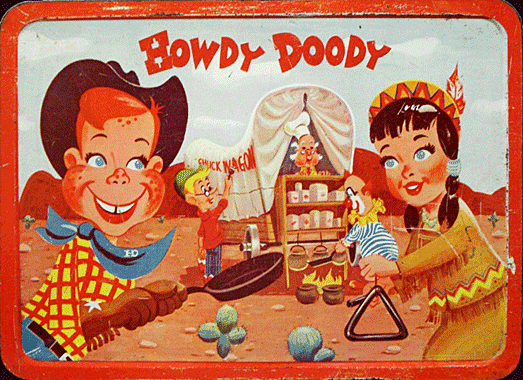
While these character mascots appeared mostly in the mid 20th century,
in fact, the first one—the Quaker Oats Quaker—dates all the way back to
1877. And although he didn’t really have anything to do with the
Quakers, the cereal company created an icon that has lasted 146 years.
Ad men refer to characters such as Aunt Jemima, Elsie the Borden Cow,
the Jolly Green Giant, and Tony the Tiger as advertising icons, but
collectors just call them advertising character collectibles. And there
are lots of them—Betty Crocker, the Energizer Bunny, the Michelin Man
and the Pillsbury Doughboy, to name a few.
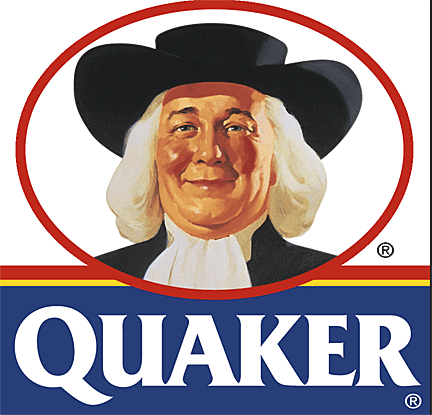 Collectors
classify advertising characters in two categories—those created by a
company specifically to sell a product, such as Aunt Jemima, and those
that became a character first, then were licensed to one or more
companies to sell a product, such as Howdy Doody. Some advertising
character collectors specialize in just one character. Collectors
classify advertising characters in two categories—those created by a
company specifically to sell a product, such as Aunt Jemima, and those
that became a character first, then were licensed to one or more
companies to sell a product, such as Howdy Doody. Some advertising
character collectors specialize in just one character.
Henry Seymour, co-founder of Quaker Oats, randomly decided on the
character after reading about Quakers in an encyclopedia. He thought the
Quaker name represented purity, honesty, and integrity, characteristics
the company wanted to portray as their brand. Early collectibles include
buttons, trade cards, booklets, a china bowl in 1910, plastic-ware from
F & F, tins and, of course my favorite, cookie jars.
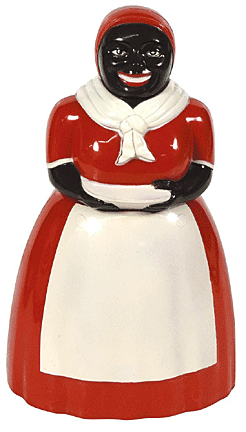 Next
came Aunt Jemima. Aunt Jemima pancake mix debuted in 1889, though the
inspiration for the character came from a minstrel show that occurred in
1875. Charles Rutt and Charles G. Underwood, creators of the self-rising
flour, named the recipe “Aunt Jemima’s recipe” after watching a minstrel
show that featured a Southern mammy named Jemima. Nancy Green, the
original actress who portrayed Aunt Jemima from 1890 until her death in
1923, was a former slave from Kentucky. Besides appearing on boxes of
pancake mix, the character of Aunt Jemima evolved into dolls, cookie
jars, syrup bottles and other memorabilia. Next
came Aunt Jemima. Aunt Jemima pancake mix debuted in 1889, though the
inspiration for the character came from a minstrel show that occurred in
1875. Charles Rutt and Charles G. Underwood, creators of the self-rising
flour, named the recipe “Aunt Jemima’s recipe” after watching a minstrel
show that featured a Southern mammy named Jemima. Nancy Green, the
original actress who portrayed Aunt Jemima from 1890 until her death in
1923, was a former slave from Kentucky. Besides appearing on boxes of
pancake mix, the character of Aunt Jemima evolved into dolls, cookie
jars, syrup bottles and other memorabilia.
Ilustrator Grace Wiederseim did sketches of cute little kids in 1904 for
a series of streetcar advertisements for Campbell Soup. The Campbell
Soup Kids, as they came to be known, began as little kids playing games
but they quickly grew up, maturing over time to begin performing more
traditional adult tasks such as climbing a fireman's ladder and
delivering ice. They quickly became very popular. The kids have spawned
a huge business in collectibles with pins, postcards, dishes and of
course dolls, as well as recipe books, kitchen decor, and table top salt
and peppers shakers, toys, and even Christmas ornaments.
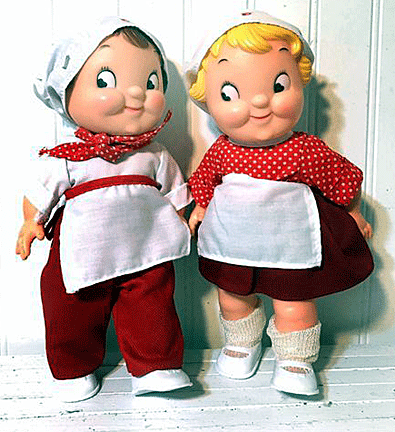
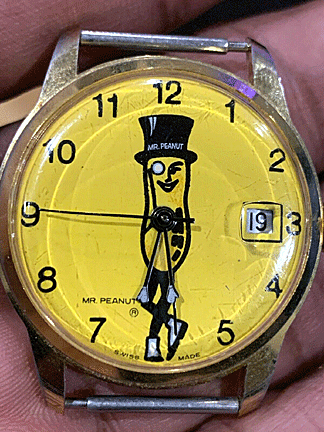 Another
oldie but a goodie is Mr. Peanut. Born in 1916 when 14 year-old Antonio
Gentile won $5 for submitting a drawing of a peanut that resembled a
person. Rumor has it that Commercial Artist, Andrew S. Wallach, enhanced
the illustration with a monocle, top hat and cane to create the iconic
image, though Planters has never positively identified the artist. He
has appeared on almost every Planters package and advertisement since
1916 and became one of the best-known icons in advertising history. Mr.
Peanut collectibles include a vintage adult Halloween costume, glass
tumblers, vintage alarm clocks, and pins, as well as books, posters,
jars, dolls, silverware, banks, watches, and salt/pepper sets. Another
oldie but a goodie is Mr. Peanut. Born in 1916 when 14 year-old Antonio
Gentile won $5 for submitting a drawing of a peanut that resembled a
person. Rumor has it that Commercial Artist, Andrew S. Wallach, enhanced
the illustration with a monocle, top hat and cane to create the iconic
image, though Planters has never positively identified the artist. He
has appeared on almost every Planters package and advertisement since
1916 and became one of the best-known icons in advertising history. Mr.
Peanut collectibles include a vintage adult Halloween costume, glass
tumblers, vintage alarm clocks, and pins, as well as books, posters,
jars, dolls, silverware, banks, watches, and salt/pepper sets.
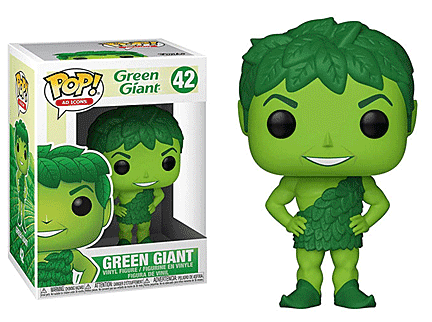
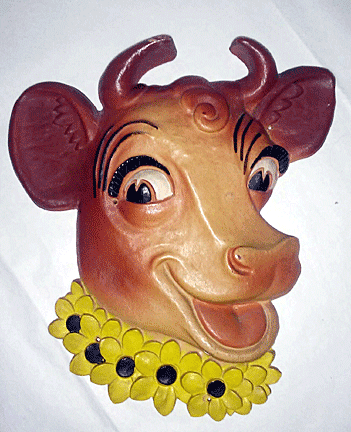 When
the Green Giant first appeared in 1928, he wasn’t very jolly. The
Minnesota Valley Canning Company created a hunched and scowling Giant.
But marketing a Giant as a mascot proved to be difficult in the
beginning. Early tv appearances left children crying at the sight of
this monster. So ad agency Erwin, Wasey & Co. came in and improved his
posture, added a smile, and made his clothing light and leafy. By 1935,
the company added the word Jolly to the Giant’s name, and by 1950, the
Minnesota Valley Canning Company had changed its name to the Green Giant
Company. When
the Green Giant first appeared in 1928, he wasn’t very jolly. The
Minnesota Valley Canning Company created a hunched and scowling Giant.
But marketing a Giant as a mascot proved to be difficult in the
beginning. Early tv appearances left children crying at the sight of
this monster. So ad agency Erwin, Wasey & Co. came in and improved his
posture, added a smile, and made his clothing light and leafy. By 1935,
the company added the word Jolly to the Giant’s name, and by 1950, the
Minnesota Valley Canning Company had changed its name to the Green Giant
Company.
Elsie the Borden Cow, one
of the most famous marketing characters ever created, came into being at
a time when consumers often feared milk to be disease-laden after a 1907
report from the USDA declared many dairy cows carried tuberculosis and
lived in unsanitary conditions.
She went on to lead the Rose Bowl parade, raise $1.6 million for World
War II bonds, collect keys to more than 600 cities, and spawned several
recipe books. Elsie has been made into dolls, toys, lamps, mugs, ceramic
items, cookie jars, as well as having her face adorn other items,
including signs, buttons and postcards.
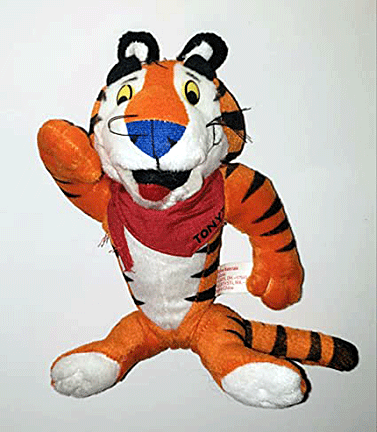 Originally
designed by Martin Provensen, author and illustrator of children's
hooks, Tony the Tiger has captured the hearts of children and adults
alike since he first appeared on Kellogg's Sugar Frosted Flakes unreal
boxes in 1952. He actually started as one of four characters that
included Katy the Kangaroo, Elmo the Elephant and Newt the Gnu. They had
a very short life, but Tony has gone on to fame promoting Kellogg's
Frosted Flakes (the name Sugar was taken out in a health conscious
wave). Like many of the characters on the icon list, Tony is depicted in
plush toys and dolls, telephone, watches, cookie jars, tins and on
cereal bowls. Originally
designed by Martin Provensen, author and illustrator of children's
hooks, Tony the Tiger has captured the hearts of children and adults
alike since he first appeared on Kellogg's Sugar Frosted Flakes unreal
boxes in 1952. He actually started as one of four characters that
included Katy the Kangaroo, Elmo the Elephant and Newt the Gnu. They had
a very short life, but Tony has gone on to fame promoting Kellogg's
Frosted Flakes (the name Sugar was taken out in a health conscious
wave). Like many of the characters on the icon list, Tony is depicted in
plush toys and dolls, telephone, watches, cookie jars, tins and on
cereal bowls.
One of the cutest ad icons are the M&M guys and gals. M & M's were first
sold to American soldiers in 1941 after Mars Sr. met Spanish soldiers
eating hard sugar-encased chocolate candies during the Spanish Civil
War. He came home, developed the recipe and the product was sold to
American soldiers as a snack that traveled well and easily in all
climates. At the time the candies were packaged in cardboard tubes. By
the late forties they were a popular candy with the public and the
packaging changed to brown paper bag we still know today. The M & M
characters were first introduced in 1954, on TV in 1972 and are more
popular than ever today. The clever and funny commercials really catch
the eye and make us identify with the different guys, like feeling sorry
for Orange and laughing at Red's antics. Toppers are particularly
popular, as well as the candy dispensers, plush figures, pins and cookie
jars. A series of special miniature toys appeared on retailer shelves
for Chirstmas, Valentine’s Day, and Easter in the last decade.
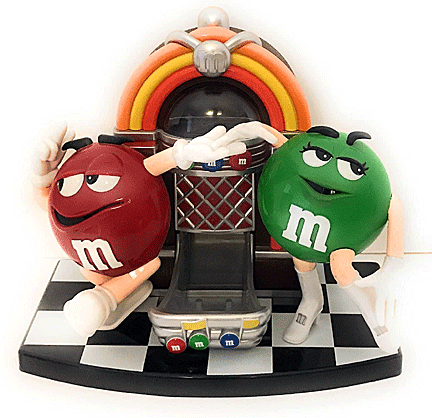
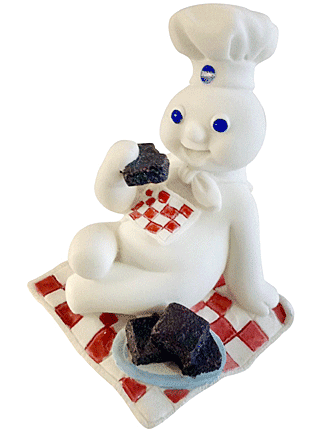 Poppin’
Fresh (aka the Pillsbury Doughboy) was born in a kitchen in Chicago in
1965. Rudy Perz, a copywriter for advertising agency Leo Burnett, helped
create an ad campaign for Pillsbury’s refrigerated dough product line.
He imagined a living dough boy popping out of a Pillsbury Crescent Rolls
can. To separate him from the rolls, Perz added a chef’s hat and a white
scarf. He also gave him big blue eyes, and made him giggle when poked in
the stomach. As you can imagine, Pillsbury Doughboy is on hundreds of
collectibles, most of them kitchen related. Dolls, clothing, radios,
ornaments, pictures, towels, and Christmas ornaments filled out the
souvenir product line. Poppin’
Fresh (aka the Pillsbury Doughboy) was born in a kitchen in Chicago in
1965. Rudy Perz, a copywriter for advertising agency Leo Burnett, helped
create an ad campaign for Pillsbury’s refrigerated dough product line.
He imagined a living dough boy popping out of a Pillsbury Crescent Rolls
can. To separate him from the rolls, Perz added a chef’s hat and a white
scarf. He also gave him big blue eyes, and made him giggle when poked in
the stomach. As you can imagine, Pillsbury Doughboy is on hundreds of
collectibles, most of them kitchen related. Dolls, clothing, radios,
ornaments, pictures, towels, and Christmas ornaments filled out the
souvenir product line.
And while many of the advertising characters are cute and cuddly, some
are worth more than the smile on kids’ faces—especially the older items.
<
Back to Readers Ask Archives
Next Article >
|
